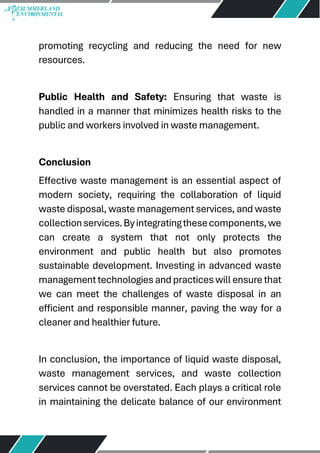Facts About Reclaim Waste Revealed
Facts About Reclaim Waste Revealed
Blog Article
Reclaim Waste Fundamentals Explained
Table of ContentsThe 25-Second Trick For Reclaim WasteReclaim Waste for DummiesReclaim Waste - An OverviewMore About Reclaim WasteThe Basic Principles Of Reclaim Waste
Domestic sewage waste refers to the waste and items from a residential septic container. The appropriate management and disposal of residential sewage waste call for fluid waste to be transferred to a sewer treatment plant where the correct approaches and devices are applied to purify and dispose of waste.
Commercial waste commonly consists of possible hazards, such as flammable materials or a mix of fluid and solid waste items, and calls for a more sophisticated and thorough disposal procedure. The disposal of business waste normally includes the filtering of waste prior to transport to guarantee secure and proper disposal. Industrial waste is developed from byproducts and overflow of industrial processes and production.
This type of waste can not make use of the very same sewer administration transportation or procedures as septic or industrial liquids. The hazardous waste management process requires the assessment and screening of liquid waste before it goes through the disposal process (liquid waste removal melbourne). Runoff waste is the liquid waste that comes from overflow and excess stormwater in very inhabited areas or cities
Overflow waste can create contamination and flooding if not dealt with correctly. Making certain appropriate waste monitoring can prevent disasters and lower ecological injury.
All about Reclaim Waste
Get in touch with PROS Providers today to discover our waste monitoring and disposal solutions and the correct ways to care for the fluid waste you create.
(https://soundcloud.com/reclaimwaste1)Do you know what happens to your water when you disengage, flush the toilet or drain pipes the washing device? No? Well, it deserves understanding. This so-called 'wastewater' is not only an important source however, after therapy, will be released to our land, waterways or the sea. Made use of water from commodes, showers, bathrooms, kitchen area sinks, laundries and industrial procedures is called wastewater.

water utilized to cool down equipment or clean plant and tools). Stormwater, a type of wastewater, is runoff that streams from agricultural and metropolitan areas such as roof coverings, parks, gardens, roadways, paths and seamless gutters into stormwater drains pipes, after rain. Stormwater flows unattended directly to local creeks or rivers, at some point getting to the sea.
The Definitive Guide to Reclaim Waste
In Queensland, the majority of wastewater is treated at sewer therapy plants. Wastewater is moved from residential or industrial sites with a system of sewage systems and pump stations, referred to as sewage reticulation, to a sewer therapy plant. Neighborhood federal governments build, preserve and operate most sewage therapy plants. Operators are certified under the Environmental Protection Act 1994 to discharge cured wastewater at an appropriate ecological standard right into waterways.
The Department of Natural Resources advises city governments regarding handling, operating and preserving sewage systems and treatment plants. In unsewered areas, local governments might require householders to install individual or house sewer therapy systems to treat domestic wastewater from toilets, kitchens, restrooms and laundries. The Division of Natural Resources authorizes making use of family systems when they are verified to be efficient.
A lot of stormwater gets no therapy. In some new class, treatment of some stormwater to remove litter, sand and crushed rock has actually started utilizing gross pollutant traps. Wastewater therapy occurs in four stages: Gets rid of solid issue. Bigger solids, such as plastics and other objects mistakenly released to sewage systems, are eliminated when wastewater is passed through displays.
Utilizes small living organisms understands as micro-organisms to break down and eliminate continuing to be check my site liquified wastes and great particles. Micro-organisms and wastes are incorporated in the sludge.
3 Easy Facts About Reclaim Waste Described
Nutrient removal is not offered in all sewage treatment plants because it needs costly specialist devices. It is ending up being extra common in Queensland. Clear liquid effluent created after therapy might still contain disease-causing micro-organisms. If this effluent is released right into waterways such as rivers or the sea, the micro-organisms will at some point pass away out.

Most wastewater moves into the sewage system. Under the Act, regional federal governments carry out approvals and permits for ecologically pertinent activities (Periods) including wastewater releases that may have a neighborhood impact.
See This Report about Reclaim Waste
Tracking gives valid details concerning water high quality and can confirm that licence problems are being fulfilled. The information obtained through monitoring offers the basis for making water high quality choices.
Report this page